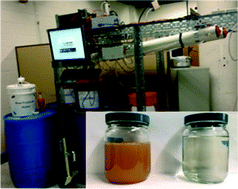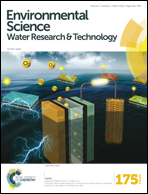A liter-scale microbial capacitive deionization system for the treatment of shale gas wastewater†
Abstract
Sustainable wastewater management is among the biggest challenges in shale oil and gas exploration and production. Here we present the first prototype microbial capacitive deionization (MCD) system for both organic carbon and total dissolved solids (TDS) removal from wastewater with simultaneous electricity production. The 2.2 liter spiral wound reactor was operated continuously for nearly 2 years using actual flow back and produced water, and it was equipped with 11 electrical sensors for real time water quality monitoring. The system was capable of generating 89–131 W m−3 power while removing up to 10.2 g TDS L−1 per day and 75% of the chemical oxygen demand (COD). Additionally, the influence of electrical potential applied to a capacitive deionization assembly on microbial electron transfer was characterized for the first time. The MCD system is inexpensive to operate ($0.10 per barrel) with an additional advantage of extra water production due to the use of sodium percarbonate as an electron acceptor. The MCD technology presents a new process for water and energy positive produced water treatment.


 Please wait while we load your content...
Please wait while we load your content...